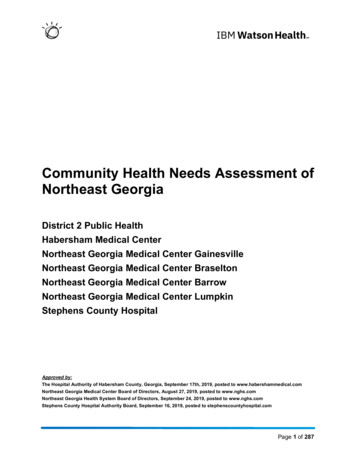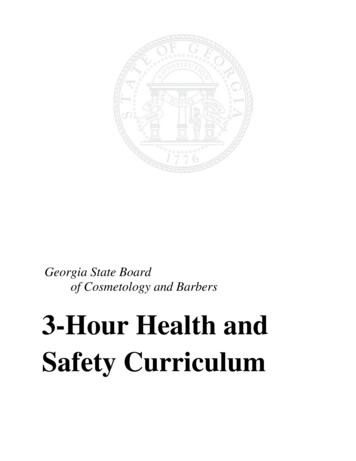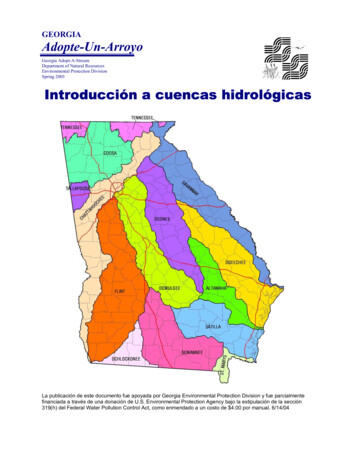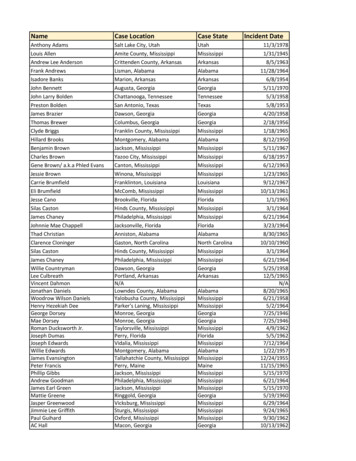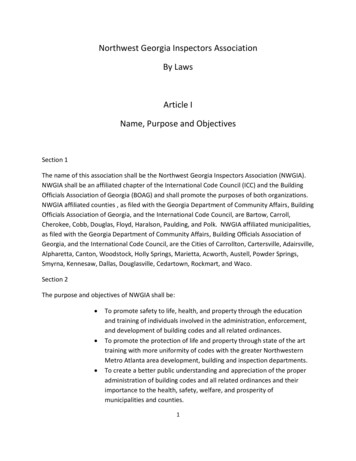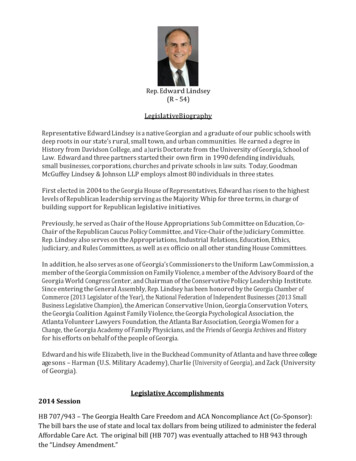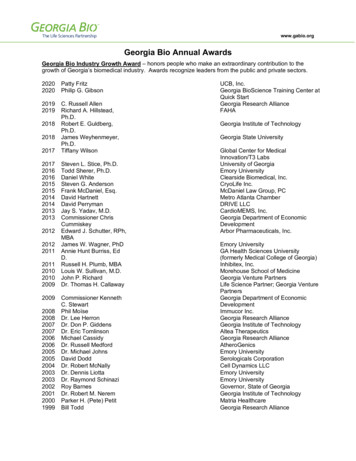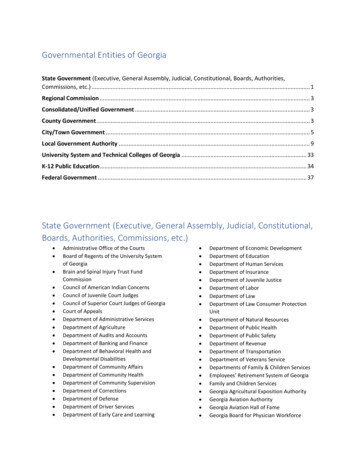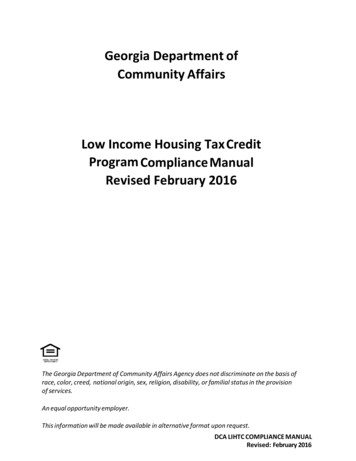
Transcription
Georgia Department ofCommunity AffairsLow Income Housing Tax CreditProgram Compliance ManualRevised February 2016The Georgia Department of Community Affairs Agency does not discriminate on the basis ofrace, color, creed, national origin, sex, religion, disability, or familial status in the provisionof services.An equal opportunity employer.This information will be made available in alternative format upon request.DCA LIHTC COMPLIANCE MANUALRevised: February 2016
Table of ContentsIntroduction . 4Background and Overview.5Chapter 1 – Program Summary .61.1 Minimum Set Aside Election. 61.2 Rent and Income Requirements. 61.3 Eligible Basis . . 81.4 Calculating the First Year Applicable Fraction . .81.5 Qualified Basis . . 91.6 Claiming Credits . 91.7 Compliance and Extended Use Period . . .91.8 Outline of DCA Compliance Process. .101.9 Owner’s Responsibility.101.10 Noncompliance.11Chapter 2 – IRS Reporting Requirements . 122.1 Low Income Housing Allocation Certification (IRS Form 8609) .122.2 Low Income Housing Credit (IRS Form 8586) .122.3 Declaration of Land Use Restrictive Covenants . 132.4 Recapture of Low Income Housing Credit Form 8611 . 13Chapter 3 – Record Keeping and Record Retention Requirements . 143.1 Record Keeping . 143.2 Record Retention . 15Chapter 4 – Monitoring: Certification and Review . 164.1 Annual Certification . 164.2 Annual Submission Requirements. 174.3 Compliance Monitoring Review Requirements . 184.4 Procedure for Compliance Inspection . 184.5 Compliance Forms . 204.6 Corrections to Documents. 204.7 Annual Monitoring Fees. 214.8Mitas System Upload 21DCA LIHTC COMPLIANCE MANUALRevised: February 2016
4.9 DCA Records Retention . 214.10 Liability. 21Chapter 5 – Project Rental Requirements.225.1 Allowable Fees and Charges . 225.2 Section 8 Rents . 235.3 Minimum Lease Requirement . 235.4 Household Size. 245.5 Full Time Resident Manager’s Unit 265.6 Utility Allowance . 285.7 Physical Requirements of Qualified Units, Suitable for Occupancy.315.8 Discrimination Prohibited in Project and General Public Use . 315.9 Vacant Units. 325.10 Student Eligibility . 335.11 Loss of Eligibility Upon Becoming a Full-Time Student . 345.12 Unit Transfers . 35Chapter 6 – Income Determinations . 366.1 Income Certification/Recertification. 366.2 Annual Income Recertification 376.3 Tenant Income Certification Form . 416.4 Annualized Income. 426.5 Annual Income . 436.6 Income from Assets . 436.7 Household Assets Do Not Include . 446.8 Assets Owned Jointly . 446.9 Instructions for Valuing Assets . 446.10 General Income Verification Requirements. 456.11 Effective Term of Verification . 47Chapter 7 – Sale, Transfer or Disposition of the Project after thePlaced-In-Service Date.48Chapter 8 – Correction and Consequences of Non-Compliance . 498.1 Notice to Owner . 49DCA LIHTC COMPLIANCE MANUALRevised: February 2016
8.2 Correction Period. 498.3 Notice to Internal Revenue Service . 498.4 Recapture of Credit . 50Chapter 9 – Compliance and Monitoring After Year 15 . 529.1 Background .529.2 Compliance Period . 529.3 Extended Use Period. 539.4 Tenant Eligibility Criteria During the Extended Use Period . 559.5 Monitoring Compliance During the Extended Use Period . 559.6 Consequences of Noncompliance During the Extended Use Period . 56Chapter 10 – Tax Credit Assistance Program (TCAP) and Section 1602 (Tax Credit Exchange)Program . 5710.1Background . 5710.2Compliance and Asset Management. 5710.3Monitoring and Reporting . 57Chapter 11 – Glossary of Tax Credit Terms. 58DCA LIHTC COMPLIANCE MANUALRevised: February 2016
IntroductionThe LIHTC program is an indirect Federal subsidy used to finance the development of affordablerental housing for low-income households. The Georgia Housing and Finance Authority (GHFA) isauthorized to allocate and issue low income housing credits under Section 42 of the InternalRevenue Code of 1986, as amended, to increase the supply of affordable housing in Georgiacommunities. The Georgia Department of Community Affairs (DCA), a legislatively createdexecutive branch of State government, administers the housing programs of GHFA. DCA is theagency responsible for the administration and monitoring of Low Income Housing Tax Credits forthe state of Georgia.The mission of the Georgia Department of Community Affairs Agency (DCA) is to partner withcommunities to help create a climate of success for Georgia’s families and businesses. In orderto achieve this mission, DCA seeks to promote and ensure the availability of decent, safe, energyefficient, and affordable housing to low and moderate- income households.This manual has been developed to assist recipients of Federal and State Tax Credits inmaintaining a multi-family rental property during the compliance and extended use periods. Thismanual is not a substitute for the requirements of the Internal Revenue Code (I.R.C.) Section42 pertaining to Tax Credits. Compliance with the IRS and HUD requirements are the soleresponsibility of the owner of any building for which Tax Credit or HOME funds have beenallocated.DCA shall be under no obligation to undertake an investigation of the accuracy of theinformation submitted for Compliance Monitoring. DCA’s review shall not constitute a warrantyof the accuracy of the information, nor of the quality or marketability of the housing to bepurchased, constructed, or rehabilitated pursuant to the program. Developers, potentialinvestors and interested parties should undertake their own independent evaluation of thefeasibility, suitability and risk of the project. If any information submitted by building owners toDCA is later found to be incorrect in any material respect, it is the responsibility of the buildingowners to inform DCA and to request a reexamination of the information. Interested partiesshould consult with a knowledgeable tax professional prior to entering into any commitmentconcerning the use and claim of housing tax credits.In January 2007, the Internal Revenue Service (IRS) released its Guide for Completing Form 8823,Low-Income Housing Credit Agencies Report of Noncompliance or Building Disposition (8823Guide), updated it in October, 2009, and again in January 2011. The 8823 Guide was not intendedto change any Section 42 rules or policies, but to provide definitions of what IRS considers “incompliance” and for consistency in reporting “out of compliance,” and “back in compliance,” onIRS Form 8823.DCA’s compliance, monitoring, and reporting policy and procedure are reflective ofinstructions in the 8823 Guide. This manual has not been reviewed or approved by4theDCA LIHTC COMPLIANCE MANUALRevised: February 2016
Internal Revenue Service (IRS) and should not be relied upon for interpretation of federalincome tax legislation or regulations.Background and OverviewSection 42 (m)(i)(B)(iii) of the Internal Revenue Code (Code) requires housing credit agencies toinclude in their Housing Tax Credit Allocation Plan a procedure to monitor all tax credit projectsfor compliance with the requirements of Section 42, the Low Income Housing Tax Credit Program(LIHTC), throughout the compliance period.An allocating agency must have a procedure for monitoring compliance with the provisions ofthe Code and notifying the Internal Revenue Service (IRS) of any noncompliance of which itbecomes aware whether or not it is corrected. The monitoring requirements became effectiveon January 1, 1992, were amended on January 14, 2000, and apply to all tax credit projects,even if the projects received an allocation prior to 1992. GHFA, as the state allocating agency, isauthorized by the Code to charge a reasonable fee to cover the costs of compliance monitoring.The IRS has issued final regulations, Income Tax Regulation 1.42-5 ("1.42-5"), relating to therequirements for compliance monitoring.The purpose of this manual is to set forth the procedures to be followed by DCA and the ownersof tax credit projects in order to comply with the requirements of Section 42. The compliancemonitoring requirements are subject to modification by the IRS and income determinationrequirements are subject to modification by HUD. DCA will review this manual annually todetermine if revisions are needed.Owners should be aware that section 1.42-5 explicitly provides that the credit agencymonitoring procedures only address the requirements for housing credit agency monitoring, anddo not address forms and other records that may be required by the IRS on examination oraudit.It is the responsibility of the owner/manager to ensure that they are using the most currentversion of all program documents and forms. Federal agencies such as HUD and the IRS frequentlyupdate materials. DCA makes every effort to post these changes to our website in a timelymanner. To keep abreast of all of the changes, the owner/manager should check the HUD, IRS andDCA websites on a regular basis.Tax Exempt Bond Projects. Some tax credit properties receive their allocation of credits throughthe use of tax-exempt bonds. DCA will monitor developments that received an allocation throughthe issuance of tax-exempt bonds, except where the bonds were issued in a sub-allocatorjurisdiction. In those cases, the sub-allocator will be responsible for compliance monitoring unlessother arrangements are made. Tax-exempt bond developments must comply with the same IRSrequirements and LIHTC compliance monitoring procedures as non-tax exempt bonddevelopments.5DCA LIHTC COMPLIANCE MANUALRevised: February 2016
Chapter 1 – Program SummaryThe following is a brief summary of the requirements of the tax credit program. It is notintended to be detailed or comprehensive.1.1Occupancy RequirementsProjects eligible for housing tax credits must meet low-income occupancy thresholdrequirements known as the minimum set-aside.Two options are available for the minimum set aside requirement:1.No less than 20% of the housing units must be set aside for tenants whose incomesare 50% or less of the area median income; or2.No less than 40% of the housing units must be set aside for tenants whose incomesare 60% or less of the area median income.Once the minimum set-aside is selected, the option cannot be changed.The IRS form 8609 is issued to document the housing credit allocation from DCA (the housingcredit agency). Each building is considered a separate project under IRC Section 42(g)(3)(D), andthe minimum set-aside applies separately to each building, unless the owner elects to treatbuildings as a multiple-building project. If the owner elects to treat buildings as a multiple buildingproject, the minimum set-aside and other project rules apply to all buildings with this election.Owners identify the building(s) in a multiple-building project by attaching a statement to theowner’s first-year tax return including IRS Form 8609, line 8b. This election also determinesprocedures for unit transfers, (See chapter 5.12, Project Rental Requirements, unit transfers).Rental agents or managers should confirm the set-aside that was established by the buildingowner at the time the set-aside option was made (the election is made on form 8609, line 10c forthe first year of the credit period), to ensure continued compliance.Owners may elect additional state-established set-aside requirements (such as additional rentrestrictions, serving certain targeted populations, etc.) as a condition of obtaining credits. Thesemay be reflected in the allocation documents, which include the Application, CarryoverAgreement, and Declaration of Land Use Restrictive Covenants. If such additional set-asides areelected, they must be maintained throughout the compliance period and extended use period(unless modified by the state HFA), and will be monitored at the same time as, and in a mannersimilar to, the Section 42 requirements.1.2Rent and Income RequirementsThe U.S. Department of Housing and Urban Development (HUD) is required by law to set incomelimits that determine the eligibility of applicants for housing programs, including the Tax Credit(Section42 program. HUD annually publishes median income figures for all Georgia counties, andDCA uses these figures to calculate the maximum allowable rents and tenant6DCA LIHTC COMPLIANCE MANUALRevised: February 2016
incomes for rental units in Tax Credit projects.The rent for each unit and established limits are based upon a percentage of area median incomeas adjusted by unit size. Maximum rents are based on tenants at maximum income paying no morethan 30% of their income for housing. Maximum rents are set by the expected occupancy, regardlessof the number of people who actually live in the unit. The formula for computing maximum grossrent is based on 1.5 persons per bedroom not to exceed 30% of the corresponding income election.Due to the Housing and Economic Recovery Act of 2008 (HERA), income limits for projectsfunded with Tax Credits and/or financed with Tax Exempt Bonds are now calculated andpresented separately from the Section 8 income limits. The Multifamily Tax Subsidy Projects(MTSPs) income limits were developed to meet the requirements established by the Housing andEconomic Recovery Act of 2008 (HERA Public Law 110-289). The MTSP income Limits are used todetermine qualification levels as well as set maximum rental rates for projects funded with taxcredits under section 42 of the Internal Revenue Code. HERA permits the income limits forprojects placed in service in 2007 and 2008 to increase over time. Beginning with the publication ofFY2009 Median Family Income estimates and Income Limits, the section 8 income limitscannot be used for Tax Credit or Tax Exempt Bond properties.Placed in Service DateThe owner must ensure that the correct limit tables are used for the property. According toHERA, the Placed in Service (PIS) date for a project determines which table to use. Projectsthat used income limits based on the FY2009 publication from HUD should use the higherincome limits of FY2009 or the current year. See the LIHTC income and rent limit tables andinstructions for which tables apply to which range of placed in service dates at the followinglink: http://www.huduser.org/portal/datasets/mtsp.html. Records must be maintained showingthe project qualifies to use these limits.When determining which table to use for properties with placed in service dates both beforeand after the income limit effective dates, also consider the following: The earliest PIS date for a building governs.Under Section 42, each building is considered a separate project unless the owner electsto treat buildings as a multiple-building project. The multiple-building election is made bythe owner on line 8b in Part II of IRS form 8609. However, since IRS form 8609 is typicallyissued well after the placed in service date, owners of properties with buildings placed inservice both before and after the publication of new limits must determine what thiselection will be and which buildings are part of the project. The Owner must document thisdetermination in the property’s records, and when completing Part II of form 8609, theelection must be consistent.The earliest PIS date for any building that is part of a multiple-building project determineswhich table will be used by all of the buildings that are part of that multiple buildingproject. Line 8b on form 8609 is or will be checked “yes” and owner has identified thebuildings that will be part of the multiple-building project.If buildings are not part of a multiple-building project, then each building may us7DCA LIHTC COMPLIANCE MANUALRevised: February 2016
a different table depending on their respective placed in service dates. Line 8b is or will bechecked “no” and therefore each building will be treated as a separate project.1.3Eligible BasisIn general, the Eligible Basis of a building is the amount of all depreciable development coststhat may be included in the calculation of Tax Credit housing. The eligible basis is equal to thebuilding's adjusted basis for acquisition, rehabilitation or construction costs for the entirebuilding, subject to certain conditions and modifications set forth in Section 42 (d). Some ofthe special provisions for determining eligible basis are included in Section 42 (d). The EligibleBasis, as of the end of the first year of the credit period, is reported to the IRS on Part II of theform 8609, and does not change from year to year.1.4Calculating the First Year Applicable FractionThe applicable fraction is the lesser of: The unit fraction, which is the number of LIHTC units in a building divided by thetotal number of residential rental units; or The floor space fraction, which is the total floor space of the LIHTC units in thebuilding divided by the total floor space of the residential rental units in the building.To determine the applicable fraction for the first year, find the low-income portion as of theend of each full month that the building was in service during the year. Add these percentagestogether and divide by 12 (per instructions on IRS Form 8609 and 8609-A). Note that theapplicable fraction must be calculated for both the unit and floor space fraction.When determining which units to include in the numerator (low-income units), and in thedenominator (total units) of the applicable fraction, please note: Units that have never been occupied or are occupied by a nonqualified householdcannot be included in the numerator, but must be included in the denominator. Vacant units that were last occupied by a nonqualified household cannot be includedin the numerator, but must be included in the denominator. Units not suitable for occupancy, including tax credit units being rehabilitated in thefirst year of the credit period, cannot be included in the numerator, but must beincluded in the denominator. Common space units (units for FT manager, FT maintenance or security – See Chapter5), are not included in either the numerator or denominator.8DCA LIHTC COMPLIANCE MANUALRevised: February 2016
1.5Qualified BasisQualified basis is the portion of the eligible basis applicable to Housing Tax Credit units in abuilding. Qualified Basis is the product of a project's Eligible Basis multiplied by the ApplicableFraction. The original qualified basis is determined as of the last day of the first year of thecredit period and is reported to the IRS on Part II of Form 8609.1.6Claiming CreditsOnce a property is placed in service, the tax credits are usually claimed over a 10 year period andare based on a percentage of the qualified costs of the building. This time period is known as thecredit period. The applicable rates are 9 percent for new construction and substantialrehabilitation and 4 percent for buildings with federal subsidies and for acquisition ( w i t h t h erehabilitation of existing buildings). In order for an existing building to qualify for the credit inconnection with substantial rehabilitation, there must be a period of at least 10 years betweenthe date of acquisition and the date the building was last placed in service. In order to claim thefull tax credits awarded, the project must satisfy specific low-income housing compliance rulesthroughout the compliance period and the extended use period, which is at least 30 years.1.7Compliance and Extended Use PeriodAll developments receiving a credit allocation must comply with eligibility requirements for aperiod of 15 years beginning with the first taxable year of a building's credit period. This istypically referred to as the “compliance period”.Extended Use Period - All developments receiving a credit allocation after December 31, 1989,must enter into a Declaration of Land Use Restrictive Covenants for Low-Income Housing TaxCredits with DCA at the time a final allocation of credit is issued, which requires developments tocomply with eligibility requirements for a minimum additional 15 years beyond the 15-yearcompliance period for a total of 30 years. This is typically referred to as the “extended useperiod.”See Chapter 9, “Compliance and Monitoring After Year 15” for details on requirements in theextended use period.9DCA LIHTC COMPLIANCE MANUALRevised: February 2016
1.8Outline of DCA Compliance ProcessDCA is responsible for establishing compliance monitoring procedures and will report instances ofnon-compliance, whether corrected or uncorrected to the Internal Revenue Service (IRS) usingIRS form 8823. Monitoring is an on-going activity that extends throughout the Extended UsePeriod, which is a minimum of 30 years. Please note, DCA inspections are not the same as an IRSaudit. Compliance with Tax Credit regulations is the responsibility of the Owner. Owners areurged to seek legal counsel and/or tax advice when establishing management and accountingpractices for their Tax Credit projects. Refer to the IRS 8823 Audit Technique Guide revisedJanuary 2011 for additional compliance monitoring requirements.1.9Owner’s ResponsibilityEach owner has chosen to utilize the LIHTC Program to take advantage of the tax benefitsprovided. In exchange for these tax benefits, certain requirements must be met.Prior to issuance of a final tax credit allocation, the owner must certify to the total project costsand provide an audit of such prepared by an independent Certified Public Accountant. Theowner must also certify that all Program requirements have been met. Any violation of therequirements of the Program could result in the loss of tax credits to the owner.The owner is responsible for compliance with the Code. Owner must take any lawful action tocomply fully with the Code and with all applicable rules, rulings, policies, procedures,regulations or other official statements promulgated or proposed by the United StatesDepartment of the Treasury, or the Internal Revenue Service, (IRS) or the Department ofHousing and Urban Development (HUD) from time to time pertaining to Owner's obligationsunder Section 42 of the Code. Any and all financial consequences to the owner as a result ofnoncompliance, whether identified by DCA or the IRS, will be the responsibility of the owner.Successful operation of a LIHTC development is management intensive and the owner isresponsible for ensuring that the project is properly administered. Thorough understanding ofLIHTC requirements and compliance monitoring procedures requires training of owners andmanagers. This training should occur before a development is occupied and should be providedto the on-site property management staff. At a minimum, such training should cover keycompliance terms, qualified basis rules, determination of rents, tenant eligibility, filedocumentation, available unit procedures and unit vacancy rules, agency reporting and recordretention requirements, and site visits. Continuing education each year or at a minimum everyother year is strongly recommended in order to keep up with regulatory and procedural changes.DCA is committed to providing training to the participants in the LIHTC and HOME programs.Periodically, DCA will offer training courses on basic and advanced principals of the Tax CreditProgram. A representative for the owner/general partner of a funded project is required tosuccessfully complete a compliance-training seminar prior to the beginning of lease-up. Thetraining may be sponsored by DCA or other organizations which provide Low Income HousingTax Credit (LIHTC) training. The owner of a Tax Credit property may be required to submit proof10DCA LIHTC COMPLIANCE MANUALRevised: February 2016
of the Tax Credit training prior to the project’s application for 8609’s.1.10NoncomplianceIf the management agent and/or the owner determines that a building o
Chapter 1 - Program Summary . 42 pertaining to Tax Compliance Credits. with the and IRS HUD requirements are the sole . In January 2007, the Internal Revenue Service released its Guide for Completing Form(IRS) 8823, Low-Income Housing Credit Agencies Report of Noncompliance or Building Disposition(8823


